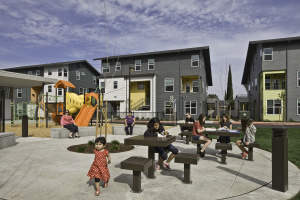Tucked away in rural Live Oak in Sutter County, and a few blocks from the main avenue, were 30 wartime-era affordable housing units that were falling apart and slowly becoming abandoned. It was determined that rehabilitation was unfeasible and the site was transformed, providing 56 units of low income family housing in 3 story buildings. The property is surrounded by a pedestrian friendly loop road and complemented by a central open space and community building.
The site plan was designed to create a centrally located community space with a new community building as the focal point.
An agricultural vernacular is expressed in the buildings with expansive shed roofs, citrus accent colors and a playful mix of siding patterns. Garden areas and courtyards allow residents to grow their own food, socialize and build community.
The project consists of 2, 3, and 4 bedroom units with a central community building that contains a daycare facility for preschoolers. Each unit has storage, a private patio or balcony, and a washer/dryer. The buildings face narrow, pedestrian friendly streets and create park-like courts of various sizes. Parking is tucked under the buildings and does not dominate the site.
Given the lack of municipal storm drainage, all runoff is retained and allowed to infiltrate the site, and numerous green features are incorporated into the design: energy performance 26-30% above T24; Green Point Rated 118pts.; low VOC materials and finishes; high thermal mass design; variable speed HVAC fans; ceiling fans; energy star appliances; low E dual pane operable windows and shades; construction/demolition waste reduction; efficient lighting; materials with recycled content; water conserving fixtures; a community garden; and water conserving landscape. The project is designed to accommodate future solar hot water and photovoltaic systems which will make it a Net Zero community.
Designed to create a centrally located community space the site includes a new community building as the focal point, with a portion of the building dedicated to day care for up to 20 pre-school aged children who participate in the local Head Start Program. Adult education classes for project residents are held in the adjacent, larger rooms. Outdoor open spaces are located near existing trees and have become small courts that subdivide the site into smaller communities. Gum Street, which previously was a dead end, has been extended through the site to create a stronger connection with the surrounding neighborhood. The private, narrow driveway-like loop slows cars and creates a safe pedestrian oriented space. All unit entries are visible from the street and create focal points for informal interaction and gathering.




